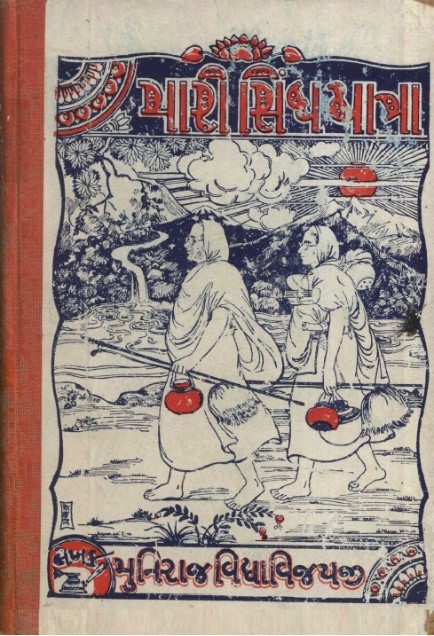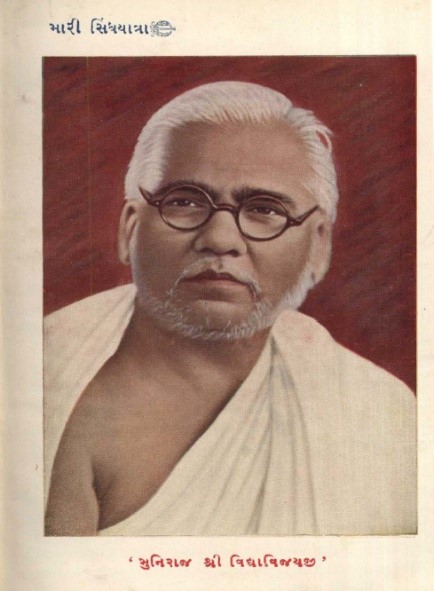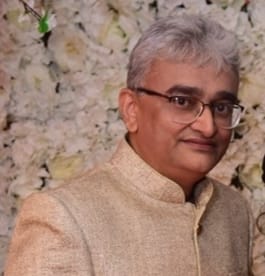
There was a time when the borders of Sindh were much wider than present. A small portion of Punjab, Afghanistan, North-West frontier, Balochistan, Bahawalpur, Rajputana and Jaisalmer were considered a part of ancient Sindh

[Editor’s Note: This is Part 01 (first) of a series of articles based on a pre-partition book named “મારી સિંધ યાત્રા” (“منهنجي سنڌ جو سفر”) in Gujarati authored by Jain Sadhu Shri Vidyavijayji, narrating his experiences of travel and stay in Karachi for about 2 and half a years between 1937 and 1939. It would be advisable to click on introductory article and read for better understanding of the series. – Nasir Aijaz, Editor Sindh Courier]
Vimal Shah, Mumbai
“There are two great rivers of the Indian sub-continent – Ganga and Sindhu. The territory that is popular by the name of Sindhu River is Sindhdesh. The territory that gets divided into East and West by the 1800 miles long Sindhu River flowing North to South is Sindhdesh. The territory that is surrounded by – Balochistan, Punjab and Bahawalpur in the North; Jaisalmer and Jodhpur riyasat (state) in the west; Arabian Sea and the Rann of Kutch in the South; and the Hala Mountain in the East – is Sindhdesh. Sindhdesh enjoys a unique significance in the Indian sub-continent. If any territory of Hindustan had to suffer the maximum number of foreign attacks, it is Sindhdesh.”
The Ancient Sindh

“There was a time when the borders of Sindh were much wider than present. A small portion of Punjab, Afghanistan, North-West frontier, Balochistan, Bahawalpur, Rajputana and Jaisalmer were considered a part of ancient Sindh. Only the North side was open from where the foreign armies used to enter and attack Sindh. The history of Sindh is very old. It is said that King Jaydrath used to rule Sindh in the period of Kauravs-Pandavs. Before 2500 years Sindh was in the control of Badshah of Iran, Darius. The Greek sardar of Darius, Scylax had attacked Hindustan with his marine fleet through Sindhu River and conquered Punjab and Sindh. Sikandar the great had also come up to Jhelum and conquered Sindh after winning Poras, the then king of Pubjab. It is said that the Europeans started getting the information regarding Hindustan only after the arrival of Sikandar.
The Sethians concurred Sindh after Sikandar, and they ruled for about 400 years. Some scholars say the Sethians are those who used to be known as ‘Shaki’. King Gardabhill used to rule Ujjain before Vikram. The ‘Shak’ dynasty uprooted Gardabhill and ruled Ujjain. Tired of the atrocities committed by Gardabhill, Jain Acharya Kaalakaacharya had brought them to uproot him, by crossing the Sindhu River and via Sindh.”
[Explanation by Vimal Shah: The ‘Shak Samvat’ popular in India has been named after the Shak dynasty. The Gachchh of Kaalakaacharya (Gachchh = sub-sect) was known as ‘Bhavdar Gachchh’ and hence his followers who settled in Punjab are known as ‘Bhavda’. There was a large population of Jain community living in the Punjab province of today’s Pakistan, who migrated to India side in 1947 en-masse and the remaining families subsequently. Even today when there are no more Jain families living there, you find several localities and structures known with their original names such as ‘Bhavdon ka mohalla’, ‘Bhavda Galli’, ‘Bhavda Bazar’, ‘Bhavdon ka Mandir’, ‘Bhavdon ki Haveli’, etc.]
The Hindu Rule in Sindh
“There were kings of Rai dynasty towards the end of 5th century AD. After that king of Brahmin dynasty ruled from the year 632 to 712.
Looking at the customs and eating habits and lifestyle of the 25% Hindus, almost everything is like Muslims
Looking at the current situation of Sindh, the total population is 38, 35,600. Out of every 100 people, there are 73 Muslim, 25 Hindu, and 2 Others (European, Christian, Parsis, etc.). Looking at the customs and eating habits and lifestyle of the 25% Hindus, almost everything is like Muslims. Seeing all these, anyone would wonder why so many Muslims in Sindh? And why are the habits of Hindus being like Muslims? The reason is Sindh has been ruled by Muslim rulers for almost 1200 years. It is surprising to see even a small number of other communities, after the territory being ruled by a single community persistently for 1200 years. One must be happy that even after having penetration of Muslim eating habits and culture, the existing 25% Hindu community takes staunch pride in being Hindu.”
The Muslim Rule
“The earliest penetration of Muslim rulers in Sindh began with Muhammed bin Qasim. Qasim invaded Sindh in 712 AD, and he conquered Devalbunder. He looted Hindu temples and conquered two forts of Nairunkot (today’s Hyderabad) and Shivistan. The one who fought Mohammad bin Qasim was Raja Dahir of Aror. Since a lot of complaints of Mohammad bin Qasim reached the Khalifa of Baghdad, he ordered to capture Qasim and bring him alive sealed in a leather bag. Within three days Mohammad bin Qasim died of suffocation in the sealed leather bag.
History says that from 712 to 1025 Sindh was ruled by Arabs, from 1025 to 1051 by Gaznavi Sultans.”
The Sumra and Sama Rule
“Sumara dynasty ruled Sindh from 1051 to 1351. Sumras were originally Rajputs. During the Arab rule they had migrated to Sindh due to famine in their land. Later they converted to Islam.
The ‘Sama’ dynasty ruled Sindh from 1351 to 1521. They had migrated from Afghanistan. King Narpat of Afghanistan and his son Sampat or ‘Samo’ came to Sindh. They and their descendants had tried to establish their rule in Sindh but they did not succeed. Their 9th generation ‘Lakhiyar bhad’ inhabited ‘Nagarsamai’ or ‘Nagarthatta’ named after ‘Sama’ and established their rule. They were followers of Hinduism. They were living in the ‘Samai’ nagar near ‘Sevan’. After gaining the control of Sindh they started living in ‘Aamui’ town near Thatta.”
“These ‘Sama’ dynasty kings were of Yadav clan. They started being recognised as ‘Jadeja’ after one ‘Jam Jada’ amongst them. Now their population is about 8 lacs in Sindh and most of them follow Islam. And the population of Sumras is about 1 lac. ‘Mod’ – the son of ‘Lakha Dhurara’ (who had inhabited Nagarsamai town) and grandson of ‘Lakhiyar bhad’, went to Kutch and established his rule there. Not only Kutch but those who established throne in Morbi, Jamnagar, Dhrol, Sardhar, Rajkot, Gondal and Okhamandal belong to the Sama clan.”
The Argun Clan Rule
“The Argun clan ruled Sindh from 1521 to 1554 AD. They were residents of Kandahar. They were descendants of a Mughal sardar named Argun. When Mirza Shah Hussein of Argun clan was ruling Sindh, Badshah Humayu of Delhi came to Sindh when a pathan named Sher Khan had driven him out. He tried to win some parts of Sindh but did not succeed. He then went to Jodhpur and later returned to Umerkot. In 1542 AD Queen of Humayun, Hameeda Begum gave birth to a child. That child was Samrat Akbar.”
The Tarkhans Rule
“From 1554 to 1590 AD Sindh was ruled by the Tarkhan clan. Tarkhan is a race of Mughals. The last king of their dynasty was Jani Beg. The throne of Sindh came in the hands of Akbar after his death.”
The Mughal Rule
“From 1590 to 1736 AD the Mughals ruled Sindh. Subas and Nawabs used to be deputed and they used to look after the administration of Sindh.”
The Kalhoras Rule
“From 1736 to 1781 AD Kalhora clan ruled Sindh. It is said that these Kalhoras had migrated to Sindh since the Period of Arabs. It is also said that they were descendants of Hazrat Abbas, the uncle of Hazrat Muhammad (Peace Be Upon Him) Paigambar (Prophet of Allah). In 1789 AD during the Periods of Ghulam Shah Kalhoro, the British came to Sindh for the very first time for trade and camped in Thatta and Shah Bunder. Ghulam Shah was brave and clever. He was son of a courtesan. Ghulam Shah is very popular amongst the Kalhora dynasty.
Today’s Hyderabad is the new city inhibited by Ghulam Shah in 1768 AD by rebuilding the fort on the land of old Nairunkot city. Ghulam Shah changed the Seat from Khudabad to Hyderabad. Therefore, many Hindus of Khudabad migrated and settled in Hyderabad.”
The Hindus of Khudabad
“It is said that many Hindus migrated from Khudabad in the Larkana district due to a major fire and settled near Hala. They named the new village they inhabited also Khudabad. Later in the Period of Ghulam Shah they migrated and settled in Hyderabad. Therefore, the new Khudabad also deserted and vanished over time. Mostly those Hindus are the ones known as ‘Aamils’ and ‘Bhaiband’.
While the Hyderabad fort was being built, these Hindus of Khudabad settled near the riverbank of Sindhu. One Giddumal was a prominent personality amongst those Hindus. Ghulam Shah had contracted the job of constructing the fort to Giddumal. This riverbank of Sindhu became popular as Giddu bandar by the name of Giddumal. Those Hindus came and settled in Hyderabad once the fort was constructed.”
The Period of Meers
“After that is the period of Meers. From 1781 to 1843 AD Meers ruled Sindh. It is said that the Meers came from Balochistan. Therefore, they are known as Baloch. Amongst them was one brave man called Talu Khan therefore they were known as Talpura. After gaining the power in Sindh they were known as Meers.” (Continues – Read second part on Sunday April 16, 2023)
__________________
About the contributor of the series of Articles based on the book
 Vimal Shah is a follower of Jainism by birth and is based in Mumbai, India. He is a Computer Engineer and holds a Diploma in Jainology from Mumbai University. He has immense interest in reading, writing, studying, and teaching Jain Philosophical subjects. He conducts classroom as well as on-line sessions on Jain Philosophical courses. He has created several power point presentations with animation which he uses while teaching and has participated in several Jain Community events to present and explain the relevant subjects to the visiting audience. He has significantly contributed to the translation, reviewing, and editing of the set of books ‘Compendium of Jainism’ of JAINA, USA from English to Gujarati – an initiative of the JAINA India Foundation. He is also associated with a Project for the translation of Jain Aagams (Scriptures) from Gujarati to English and continues to study various subjects and remains a student of Jain Philosophy. He has a special interest in the history and preservation of the Jain Heritage in Pakistan, and is associated with the Jain Heritage Foundation, New Delhi.
Vimal Shah is a follower of Jainism by birth and is based in Mumbai, India. He is a Computer Engineer and holds a Diploma in Jainology from Mumbai University. He has immense interest in reading, writing, studying, and teaching Jain Philosophical subjects. He conducts classroom as well as on-line sessions on Jain Philosophical courses. He has created several power point presentations with animation which he uses while teaching and has participated in several Jain Community events to present and explain the relevant subjects to the visiting audience. He has significantly contributed to the translation, reviewing, and editing of the set of books ‘Compendium of Jainism’ of JAINA, USA from English to Gujarati – an initiative of the JAINA India Foundation. He is also associated with a Project for the translation of Jain Aagams (Scriptures) from Gujarati to English and continues to study various subjects and remains a student of Jain Philosophy. He has a special interest in the history and preservation of the Jain Heritage in Pakistan, and is associated with the Jain Heritage Foundation, New Delhi.